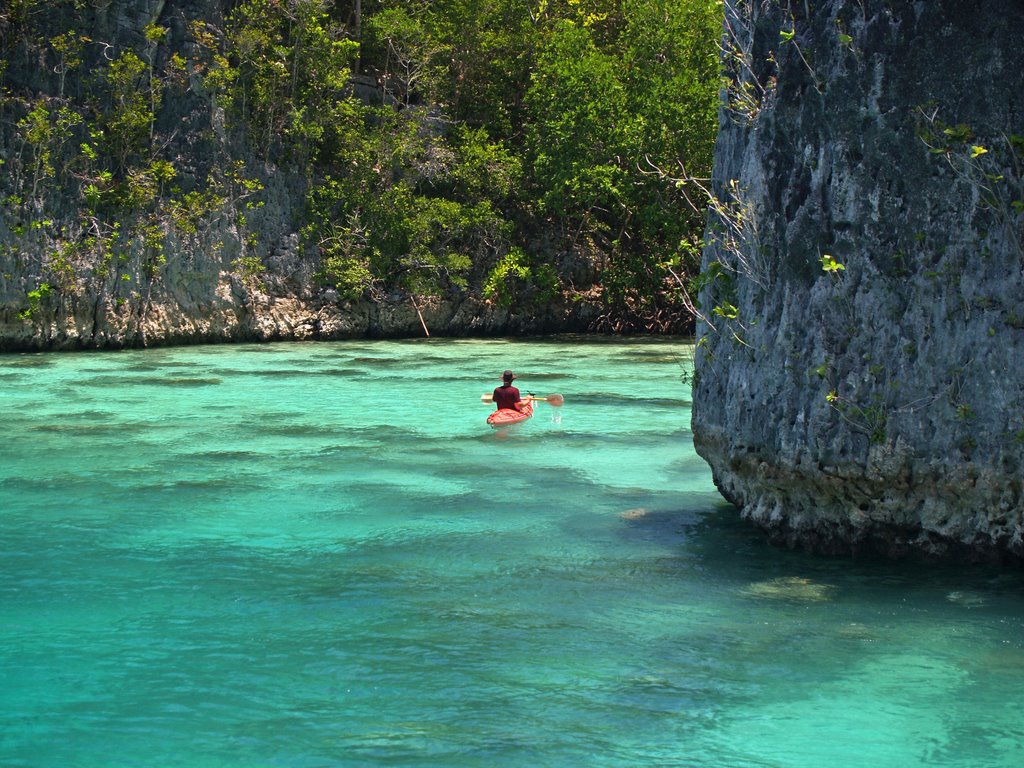PapuaAround.com – Batanta Island holds many interesting objects, ranging from hundreds of years old mangroves, the Warinka Bom waterfall, underwater historical relics in the form of WWII-era fighter planes, to dozens of wild orchids.
This beautiful island in Raja Ampat is an amazing paradise in the province of West Papua. Raja Ampat has four large islands such as Misool, Waigeo, Salawati and Batanta.
Each island has a different beauty.
Batanta Island is about 34 kilometers from Sorong, about an hour away by speedboat.
This 60 square kilometer island has natural ecosystems such as beaches, tropical rain forests, and dense and towering trees.
The beach has fine white sand and clear blue water. Rows of coral reefs in shallow waters up to a depth of 40cm will immediately welcome anyone who visits this place.
This place is the best place for those who love to dive. Not only coral reefs, but millions of colorful ornamental fish.
Diving tourists can see historical relics of World War II in the Pacific region, namely the ruins of foreign warplanes that sank under the Batanta Sea.
In some places, one kilometer of water sticking out of the lips is used by local residents to cultivate pearl oysters.
Although large, the island is only inhabited by 300 people from the Marandan Weser and Yarweser tribes in Wayman, Yenanas, and Wailebet.
Read : The Raja Ampat Islands Are the Center of the World’s Coral Triangle
Mangrove Forest and Waterfall
Batanta also has a mangrove swamp ecosystem covering an area of about 3 hectares. Among these hundreds of species, there are dozens of very large trunks estimated to be hundreds of years old.
The roots are large, 20-30 cm in diameter, sticking out of the stem and sticking to a wet surface.
The arch at the top of the root extends even beyond the adult human body.
Such a view is very rare in similar mangrove ecosystems in the country.
At least two tributaries to the east and west of the island provide access to this unique mangrove ecosystem.
The mangrove area in the middle of the island is the entrance to the beautiful 10 meter high waterfall area which is a favorite of tourists.
Its name is Warinka Bom Waterfall, which in the local language means endless water.
The source of the waterfall comes from a spring on the island’s highest peak.
The journey to the waterfall begins with a small pier on the bank of the Batanta tributary that separates the mangroves.
Visitors can cross a 100-meter long wooden bridge that connects mangroves and tropical rain forests, thousands of trees grow tightly like umbrellas, protecting us from the impenetrable rays of the sun.
If lucky, visitors can meet the iconic birds of Papua, and all kinds of paradise fly freely through the forest.
The waterfall terrain is very steep. Visitors must take tree roots and ropes and crawl along the edge of the cliff or along the edge of the small clear water to save time.
After walking for an hour, visitors will arrive at the waterfall.
Home for Wild Orchids
Batanta Island is also home to dozens of wild orchids.
Researchers from the National Research and Innovation Agency (BRIN) in collaboration with the Natural Resources Conservation Center (BBKSDA) of West Papua found 90 species of orchids.
Some of these species have not been discovered and are still under research conducted since March 2022.
One that was found was the orchid Dendrobium cuneatum.
BRIN researcher Destario Metusala explained that this green miniflower orchid was previously only found in Sulawesi and Maluku.
“The discovery of this species on Batanta Island (Papua region) will add information about its natural range, which turns out to be past the Wallace zone and into the Australasia biogeographic zone,” he said in BRIN News recently explaining in a broadcast.
In addition, the researchers found Taeniophyllum toricellense, an orchid root previously found only on San Cristobal Island in the Solomon Islands and in the Torricelli Mountains in Papua New Guinea.
The team also found the epiphytic orchid Dendrobium incumbens, which was previously recorded from only two locations in Papua New Guinea, namely Sepik and Morrobe.
The location above is quite far from Batanta Island in West Papua.
The researchers also managed to uncover the interesting finding that local indigenous people are working hard to utilize more than 100 species of plants for various purposes.
This plant is used for various purposes, ranging from medicine, local food, clothing, traditional ceremonies, handicrafts, household appliances, buildings, to boat-building materials, said Reza Saputra, researcher at West Papua BBKSDA.
The Batanta tribe uses a wild plant (Coscinium fenestratum) that grows in the forest as a traditional herbal medicine for malaria, eye pain, digestive disorders and fatigue.
There is also a teliih plant (Terminalia catappa) that grows on the beach and is used to treat open wounds, indigestion and diarrhea.

